
|   |

|   |
e-mail: srjan.bbsr@gmail.com Aikyam: The Art of One - Echoes of ManyJune 23, 2025 Guru Shradha is committed to preserving and promoting the profound legacy of Guru Kelucharan Mohapatra's Odissi dance tradition, while fostering cultural exchange through the transformative power of classical performing arts. The organisation envisions creating a vibrant community where the timeless beauty of Indian classical dance flourishes in modern America, reaching and inspiring audiences across generations and cultural backgrounds. Founded in 2008 by Guru Kelucharan Mohapatra's distinguished disciple, Niharika Mohanty, Guru Shradha has grown into one of the premier Odissi dance institutions in North America. Headquartered in Palo Alto, the institution was established with the blessings of Guru Kelucharan Mohapatra himself and is recognised as one of his important global extensions. Over the years, Guru Shradha has gained wide acclaim, including the 2019 Best of Palo Alto Award for Best Dance School. It continues to enrich the cultural landscape through regular classes, workshops, lecture demonstrations, festivals, tours, and innovative collaborative presentations. In continuation of its efforts to uphold the essence of classical tradition, Guru Shradha recently presented Aikyam-a solo Odissi dance evening-on 15th June 2025 at the Sunnyvale Auditorium in the San Francisco Bay Area. This initiative comes at a critical juncture when solo performances, which form the very core of Indian classical dance, are increasingly overshadowed by group presentations. As a dedicated practitioner of Odissi, I deeply commend and admire Niharika Mohanty, the Director of Guru Shradha, for her visionary leadership in bringing solo dancing back into focus. Through this thoughtful endeavour, Guru Shradha reaffirms its commitment to artistic excellence and to nurturing individual expression in the realm of classical dance in North America. Guru Shradha's seasoned disciples presented a captivating solo Odissi recital, celebrating the many hues of the dance form. From the auspicious invocations of Mangalacharan to the lyrical grace of Pallavi and the evocative depths of Abhinaya, their performances illuminated the timeless brilliance of Guru Kelucharan Mohapatra's choreographies. Each dancer expressed their individuality while resonating in a collective rhythm - a reflection of Aikyam, a profound Sanskrit term that signifies oneness, unity, or harmony. It hints at the fundamental truth that beneath all diversity lies an indivisible wholeness - the seamless union of the self with the universe, the individual with the divine. Aikyam, Guru Shradha's thoughtfully curated solo dance evening, stood as a compelling affirmation of the core spirit of Indian classical dance. It offered a rare and refreshing celebration of the solo tradition - where the individual dancer becomes both storyteller and sculptor of rhythm. Under the artistic direction of Niharika Mohanty, the evening unfolded as a heartfelt tribute to the Odissi legacy of Guru Kelucharan Mohapatra and to the timeless depth, nuance, and expressive power of solo performance. The evening opened with Shiva Taṇḍava Stotram, gracefully performed by Kanika Mitra Bhattacharya. Set in raga Bhatiar and tala Khemta, this majestic Sanskrit hymn, choreographed by Guru Kelucharan Mohapatra to the powerful music composed by Pt. Bhubaneswar Mishra, is attributed to the great devotee Ravaṇa and celebrates Lord Shiva's cosmic dance of creation and dissolution. Bhattacharya captured the hymn's vivid imagery-the descent of Ganga through Shiva's matted locks, serpents adorning his neck, and the celestial fire gleaming on his forehead. The item was performed with sincerity and served as a suitable opening to the evening. 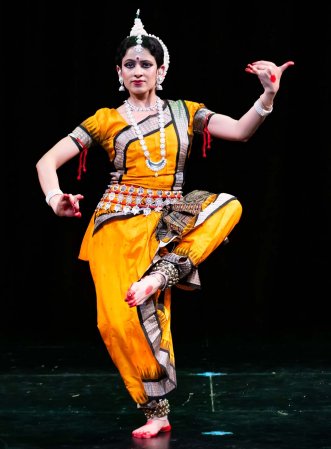 Kanika Mitra Bhattacharya  Maya Devalcharuvu This was followed by the enchanting abhinaya "Bha", Champu from the classical Odia literary tradition of Kabisurya Baladev Rath, presented by Maya Devalcharuvu. Set to tala Tripuṭa and raga Kedar Gauda, the piece was choreographed by Guru Kelucharan Mohapatra and adorned with a traditional music composition enhanced by the evocative arrangements of Pt. Bhubaneswar Mishra, which deepened the musical texture and emotional richness of the item. In this expressive portrayal, the dancer embodied a sakhi who lovingly cautions Radha to remain grounded, even as she is drawn to the irresistible beauty of Krishna. Through her nuanced abhinaya, Devalcharuvu brought to life the sakhi's tender concern and emotional restraint with grace and lyrical depth, weaving a heartfelt connection to Krishna's divine charm. Next, Maya Gollamudi offered a pure dance interpretation through a Pallavi in raga Shuddha Dhaivat Bibhas, set to tala adi, choreographed by Guru Ratikant Mohapatra, with a melodious score composed by Pradeep Kumar Das. Her performance explored the lyrical structure of the raga with technical finesse and aesthetic balance. The movement vocabulary, marked by clarity and rhythmic complexity, was enriched by her graceful stage presence and meditative composure.  Maya Gollamudi 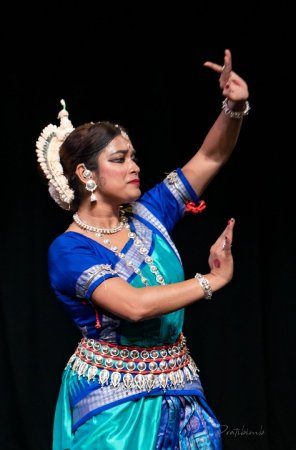 Divya Saha Divya Saha followed with a soulful portrayal of Dhira Samire Yamuna teere, one of the most poignant ashtapadis from Jayadeva's Gita Govinda. Set in raga Mohana and tala Ekatali, choreographed by Guru Kelucharan Mohapatra with music by Pt. Bhubaneswar Mishra, this piece depicted the longing of Krishna and the sakhi's gentle persuasion of Radha. Saha brought out the emotional duality of separation and anticipation through her fluid expressions, portraying both the beauty of the natural world and the inner landscape of divine love. A change in tempo and mood came with a Pallavi in raga Behag, performed with finesse by Namrata Mohanty. Structured in tala Ekatali, this pure dance number choreographed by Guru Kelucharan Mohapatra and set to the evocative musical composition of Pt. Bhubaneswar Mishra, was executed with lyrical elegance and refined grace. Mohanty navigated the intricate rhythm with serenity and fluidity, highlighting the tender and graceful character of the raga. 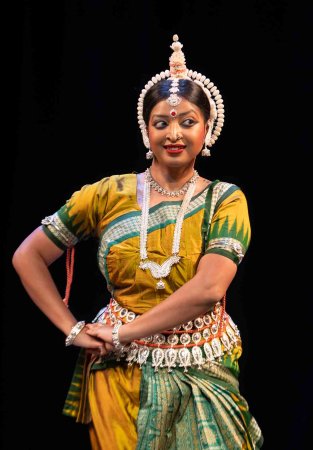 Namrata Mohanty 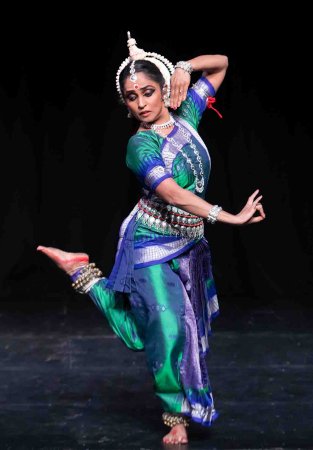 Deepa Mahadevan A spiritual high point of the evening was Ahe Nila Shaila, performed by Dr. Deepa Mahadevan. This abhinaya piece, rooted in raga Mishra Arabhi and tala Jati, was choreographed by Guru Kelucharan Mohapatra and set to a traditional musical composition with additional suitable music by Pt. Bhubaneswar Mishra, enhancing the depth and resonance of its musicality. Based on a bhakti poem by the Muslim devotee Salabega in praise of Lord Jagannath, the item unfolded with poignant devotion. Dr. Mahadevan's heartfelt portrayal of mythological episodes-from Draupadi's divine rescue to Narasimha's fierce incarnation-radiated sincerity and spiritual fervor, making it one of the most emotionally stirring presentations of the evening. Returning to pure dance, Anjana Mohanty offered a Pallavi in raga Kirwani, set to tala Khemta, choreographed by Guru Kelucharan Mohapatra and musically rendered by Pt. Bhubaneswar Mishra. Her performance was marked by confident rhythm and lyrical motion, effectively capturing the intensity and subtle modulations of the raga. The nuanced choreography was delivered with skill and grace, engaging the audience through her quiet command of the stage. 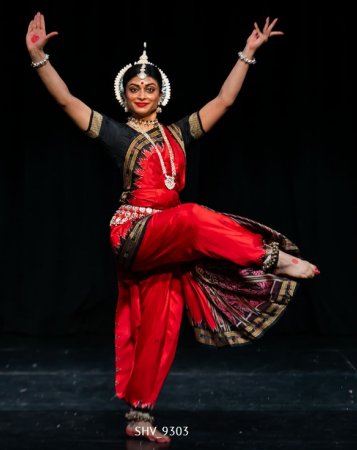 Trina Sarkar 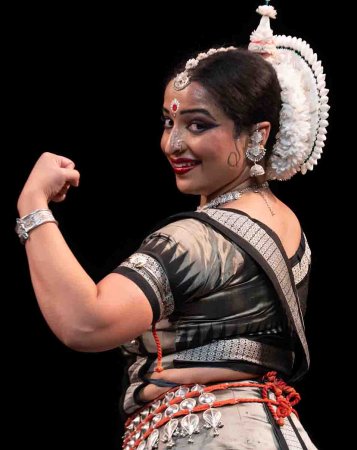 Anjana Mohanty The penultimate item, Durga Dhyana, performed by Trina Sarkar, offered a vivid invocation of Goddess Durga. Set in Ragamalika and woven through tala Ekatali and Jati, with choreography by Guru Kelucharan Mohapatra and music composed by Debasish Sarkar, this hymn celebrated the divine feminine in all her might and compassion. Sarkar's performance, with its visual clarity and emotive strength, portrayed the goddess's celestial form with deep reverence and artistry. The grand finale, Om Sarveṣam Svastir Bhavatu, brought all eight dancers together in a collective prayer for universal well-being and peace. Choreographed by Guru Ratikant Mohapatra and set to Ragamalika with a serene composition by Pt. Anup Jalota, this group presentation was both spiritually uplifting and visually cohesive. The final chant of "Om Shanti Shanti Shanti" echoed through the auditorium, leaving the audience with a sense of serenity and oneness. 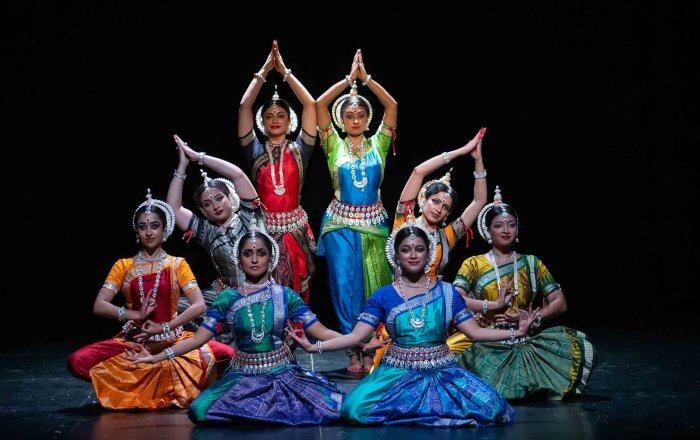 The evening was brilliantly emceed by Rasika Kumar, and the effective lighting designed by Ganesh Vasudev, further enhanced the performances. The presence of Celine Schein Das, Executive Director of Pt. Chitresh Das Institute, San Francisco State University as the Guest of Honour, added to the occasion's grace. The entire program unfolded seamlessly, with the audience deeply engaged and responding warmly after every item. Kudos to Niharika Mohanty and Guru Shradha for their unwavering commitment to excellence in Odissi and for continuing the glorious legacy of Guru Kelucharan Mohapatra through such thoughtfully curated presentations. 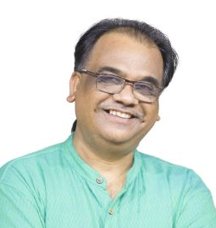 Ratikant Mohapatra, as Director of Srjan and Dean of the Faculty of Arts, Communication, and Indic Studies at Sri Sri University, stands as a distinguished figure in Indian classical dance. With a career spanning over 40 years, his artistry as a dancer, choreographer, and educator has profoundly shaped Odissi's journey. Under his guidance, Srjan has earned national and global acclaim, merging neo-classical innovation with traditional grace. Honoured with the Central and State Sangeet Natak Akademi Awards and a Guinness World Record for orchestrating 555 Odissi dancers, his legacy reflects a steadfast dedication to the evolution and timeless beauty of Odissi. Post your comments Please provide your name and email id along with your comment. All appropriate comments posted with name and email id in the blog will also be featured in the site. |